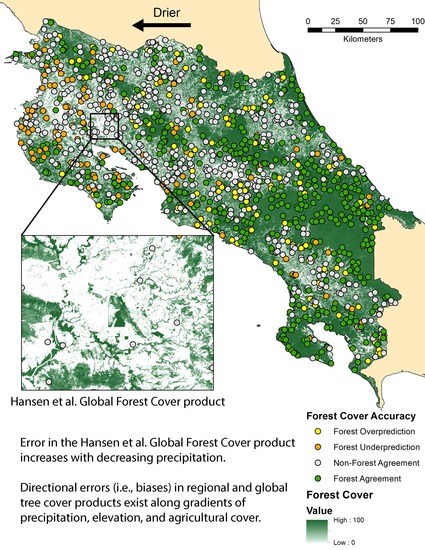Identifying Biases in Global Tree Cover Products: A Case Study in Costa Rica
Abstract
:1. Introduction
2. Materials and Methods
2.1. Study Area
2.2. Tree Cover Products
2.3. Reference Data
2.4. Accuracy Assessment and Tree Cover Thresholding
2.5. Bias Assessment
3. Results
3.1. Tree Cover Threshold Analysis
3.2. Global and Regional Map Accuracy
3.2.1. Accuracy of Continuous Tree Cover (GFC Only)
3.2.2. Comparing Forest/Non-forest Map Accuracy Across Tree Cover Products
3.3. Biases in Estimation of Tree Cover
3.3.1. Forest/Non-forest Biases along Precipitation and Elevation Gradients
3.3.2. GFC Tree Cover Biases along Precipitation and Elevation Gradients
3.3.3. Tree Cover Biases along Agricultural Gradients
4. Discussion
4.1. Comparative Accuracy of Global and Local Tree Cover Products
4.2. Biases in Estimation of Tree Cover
5. Conclusions
Supplementary Materials
Author Contributions
Funding
Acknowledgments
Conflicts of Interest
Appendix A
| Reference data thresholded at 89% | ||||
| GFC, 89% threshold | Reference Data | |||
| Predicted | Nonforest | Forest | Total | User Acc. |
| Nonforest | 495 | 119 | 614 | 80.6 |
| Forest | 103 | 437 | 540 | 80.9 |
| Total | 598 | 556 | 1154 | Overall |
| Prod. Acc. | 82.8 | 78.6 | 80.8 | |
| GCL | Reference Data | |||
| Predicted | Nonforest | Forest | Total | User Acc. |
| Nonforest | 451 | 56 | 507 | 89.0 |
| Forest | 147 | 500 | 647 | 77.3 |
| Total | 598 | 556 | 1154 | Overall |
| Prod. Acc. | 75.4 | 89.9 | 82.4 | |
| Landa | Reference Data | |||
| Predicted | Nonforest | Forest | Total | User Acc. |
| Nonforest | 436 | 71 | 507 | 86.0 |
| Forest | 162 | 485 | 647 | 75.0 |
| Total | 598 | 556 | 1154 | Overall |
| Prod. Acc. | 72.9 | 87.2 | 79.8 | |
| Reference data thresholded at 60% | ||||
| GFC, 60% threshold | Reference Data | |||
| Predicted | Nonforest | Forest | Total | User Acc. |
| Nonforest | 359 | 91 | 450 | 79.8 |
| Forest | 153 | 551 | 704 | 78.3 |
| Total | 512 | 642 | 1154 | Overall |
| Prod. Acc. | 70.1 | 85.8 | 78.9 | |
| GCL | Reference Data | |||
| Predicted | Nonforest | Forest | Total | User Acc. |
| Nonforest | 412 | 95 | 507 | 81.3 |
| Forest | 100 | 547 | 647 | 84.5 |
| Total | 512 | 642 | 1154 | Overall |
| Prod. Acc. | 80.5 | 85.2 | 83.1 | |
| Reference data thresholded at 60% | ||||
| Landa | Reference Data | |||
| Predicted | Nonforest | Forest | Total | User Acc. |
| Nonforest | 393 | 114 | 507 | 77.5 |
| Forest | 119 | 528 | 647 | 81.6 |
| Total | 512 | 642 | 1154 | Overall |
| Prod. Acc. | 76.8 | 82.2 | 79.8 | |
| Reference data thresholded at 30% | ||||
| GFC, 30% threshold | Reference Data | |||
| Predicted | Nonforest | Forest | Total | User Acc. |
| Nonforest | 270 | 86 | 356 | 75.8 |
| Forest | 138 | 660 | 798 | 82.7 |
| Total | 408 | 746 | 1154 | Overall |
| Prod. Acc. | 66.2 | 88.5 | 80.6 | |
| GCL | Reference Data | |||
| Predicted | Nonforest | Forest | Total | User Acc. |
| Nonforest | 327 | 180 | 507 | 64.5 |
| Forest | 81 | 566 | 647 | 87.5 |
| Total | 408 | 746 | 1154 | Overall |
| Prod. Acc. | 80.1 | 75.9 | 77.4 | |
| Landa | Reference Data | |||
| Predicted | Nonforest | Forest | Total | User Acc. |
| Nonforest | 332 | 175 | 507 | 65.5 |
| Forest | 76 | 571 | 647 | 88.3 |
| Total | 408 | 746 | 1154 | Overall |
| Prod. Acc. | 81.4 | 76.5 | 78.2 | |
| Reference data thresholded at 89% | |||||
| GFC, 89% threshold | Reference Data | ||||
| Predicted | Nonforest | Forest | Total | User Acc. | Original Map Area (km2) |
| Nonforest | 0.394 | 0.0947 | 0.489 | 80.6 | 29675 |
| Forest | 0.098 | 0.414 | 0.511 | 80.9 | 31049 |
| Total | 0.492 | 0.508 | 1 | Overall | Corrected Area (km2) |
| Prod. Acc. | 80.2 | 81.4 | 80.8 +/− 2.3 | NF: 29846 +/− 1387 For: 30878 +/− 1387 | |
| GCL | Reference Data | ||||
| Predicted | Nonforest | Forest | Total | User Acc. | Original Map Area (km2) |
| Nonforest | 0.373 | 0.0463 | 0.419 | 89.0 | 25451 |
| Forest | 0.132 | 0.449 | 0.581 | 77.2 | 35290 |
| Total | 0.505 | 0.495 | 1 | Overall | Corrected Area (km2) |
| Prod. Acc. | 73.8 | 90.7 | 82.2 +/− 2.2 | NF: 30658 +/− 1335 For: 30083 +/− 1335 | |
| Landa | Reference Data | ||||
| Predicted | Nonforest | Forest | Total | User Acc. | Original Map Area (km2) |
| Nonforest | 0.337 | 0.0549 | 0.392 | 86.0 | 23816 |
| Forest | 0.152 | 0.456 | 0.608 | 75.0 | 36908 |
| Total | 0.489 | 0.511 | 1 | Overall | Corrected Area (km2) |
| Prod. Acc. | 68.9 | 89.2 | 79.8 +/− 2.4 | NF: 29722 +/− 1428 For: 31002 +/− 1428 | |
Appendix B
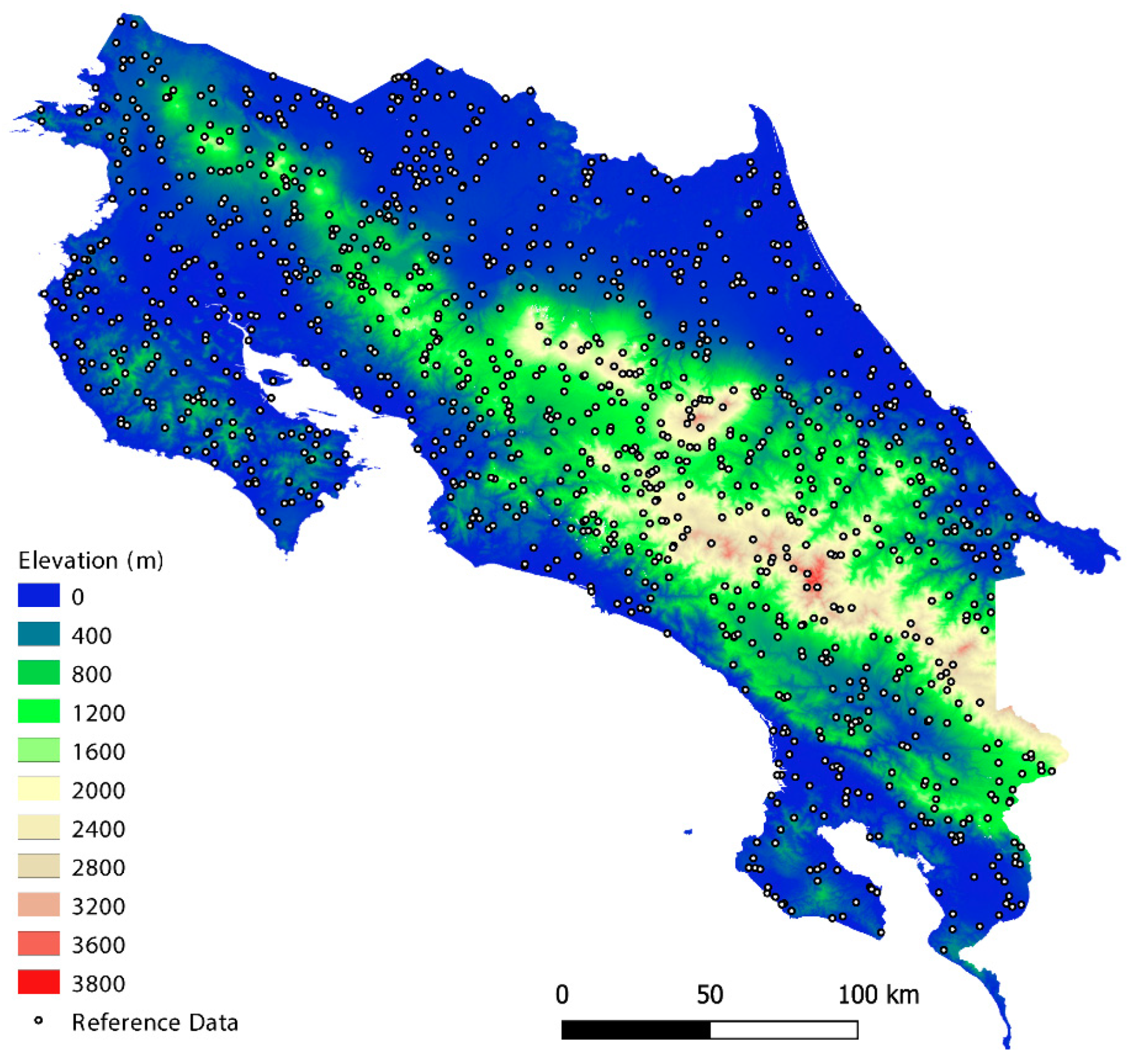
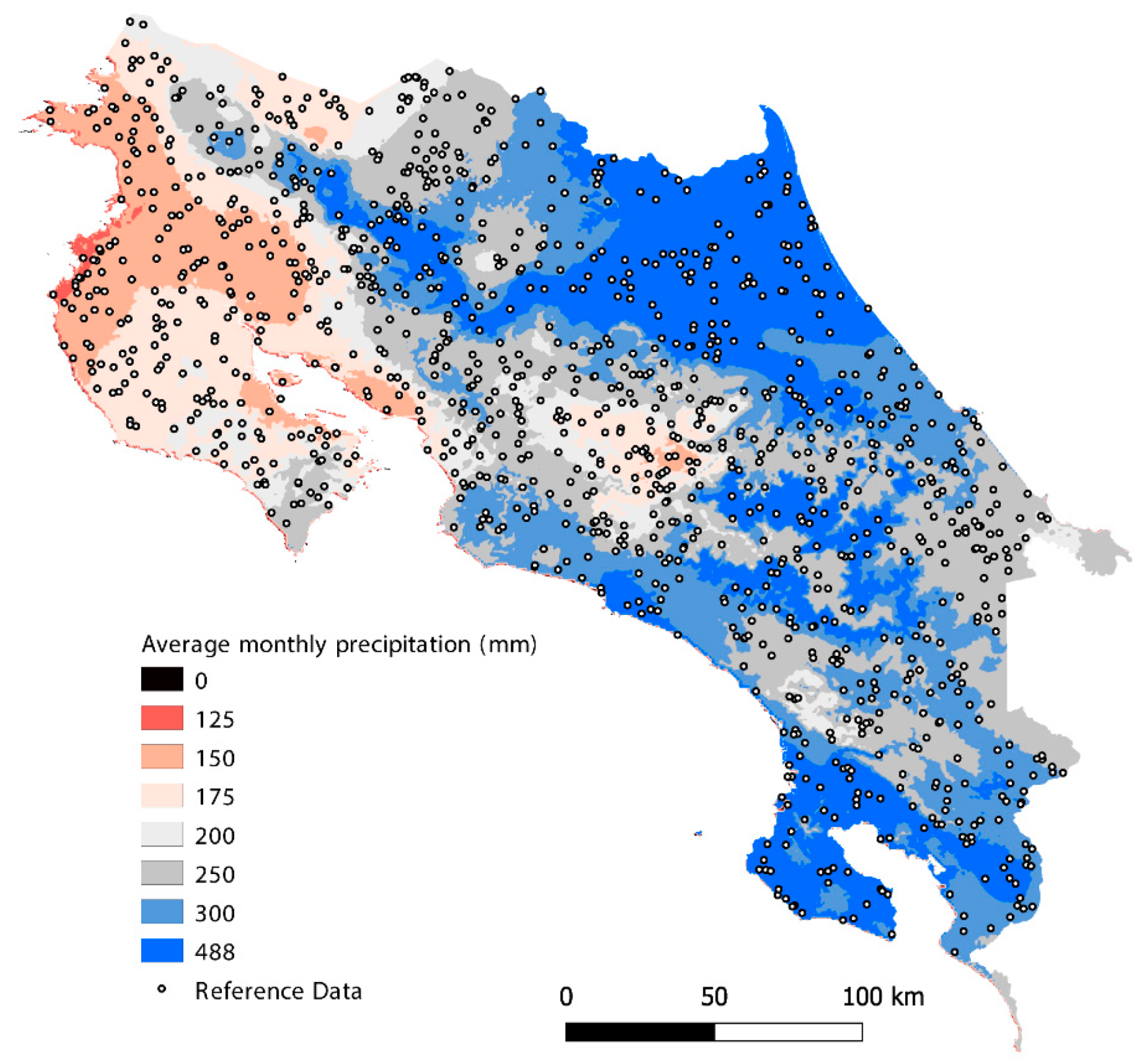
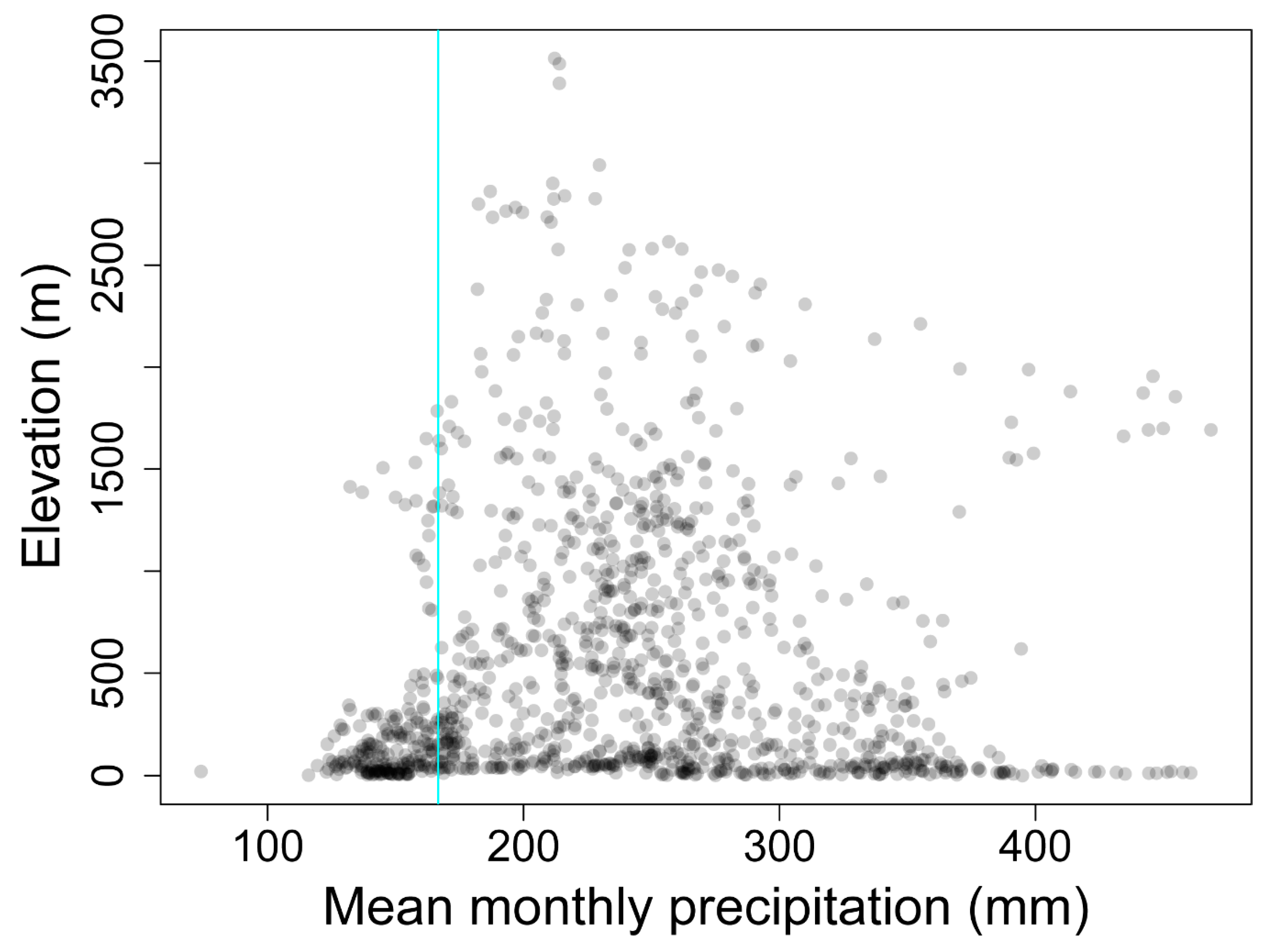
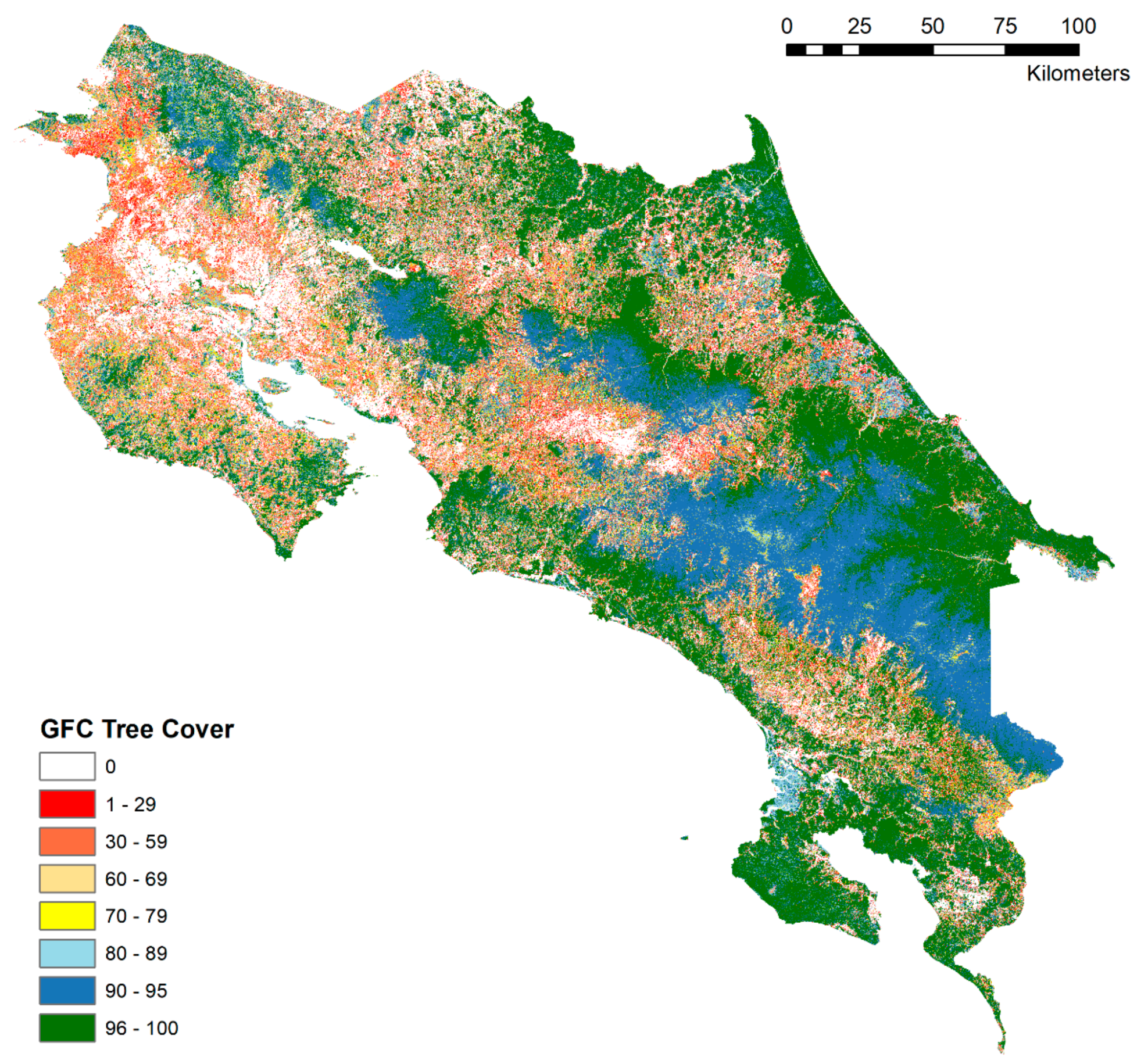
| Non-Forest Logistic Model (All Products) | |||
|---|---|---|---|
| Predictors | Estimate | Std. Error | p-Value |
| Precipitation | −0.0017144 | 0.002415 | 0.4778 |
| GFC product | −4.0014035 | 0.6849305 | <0.0001 |
| Landa product | −2.910978 | 0.6438071 | <0.0001 |
| GCL product | −1.5764706 | 0.589835 | 0.0075 |
| Elevation | 0.0008226 | 0.0002233 | 0.0002 |
| Precipitation: GFC | 0.0102934 | 0.0034168 | 0.0026 |
| Precipitation: Landa | 0.0053222 | 0.0034186 | 0.1195 |
| Elevation: GFC | −0.0005028 | 0.0003418 | 0.1413 |
| Elevation: Landa | −0.0002368 | 0.000324 | 0.4647 |
| Forest Logistic Model (All Products) | |||
| Predictors | Estimate | Std. Error | p-Value |
| Precipitation | 0.003303 | 0.002048 | 0.1068 |
| GCL product | 1.324 | 0.5045 | 0.0087 |
| GFC product | −3.651 | 0.4903 | <0.0001 |
| Landa product | 0.2989 | 0.4548 | 0.511 |
| Elevation | 0.00009815 | 0.0002087 | 0.6382 |
| Precipitation: GFC | 0.01636 | 0.003107 | <0.0001 |
| Precipitation: Landa | 0.002722 | 0.002821 | 0.3347 |
| Elevation: GFC | 0.0008794 | 0.0003262 | 0.007 |
| Elevation: Landa | 0.0002165 | 0.0002954 | 0.4636 |
| Forest Logistic Model (GFC Product) | |||
| Predictors | Estimate | Std. Error | p-Value |
| (Intercept) | 0.1112 | 0.05537 | 0.0451 |
| Precipitation | 0.002366 | 0.0002089 | <0.0001 |
| Elevation | 0.0001257 | 0.00002141 | <0.0001 |
| Forest Logistic Model (Landa Product) | |||
| Predictors | Estimate | Std. Error | p-Value |
| (Intercept) | 0.6927 | 0.05092 | <0.0001 |
| Precipitation | 0.0006298 | 0.0001921 | 0.0011 |
| Elevation | 0.00003345 | 0.00001969 | 0.0899 |
| Forest Logistic Model (GCL Product) | |||
| Predictors | Estimate | Std. Error | p-Value |
| (Intercept) | 0.8214 | 0.04638 | <0.0001 |
| Precipitation | 0.0002868 | 0.000175 | 0.102 |
| Elevation | 0.000009398 | 0.00001793 | 0.6 |
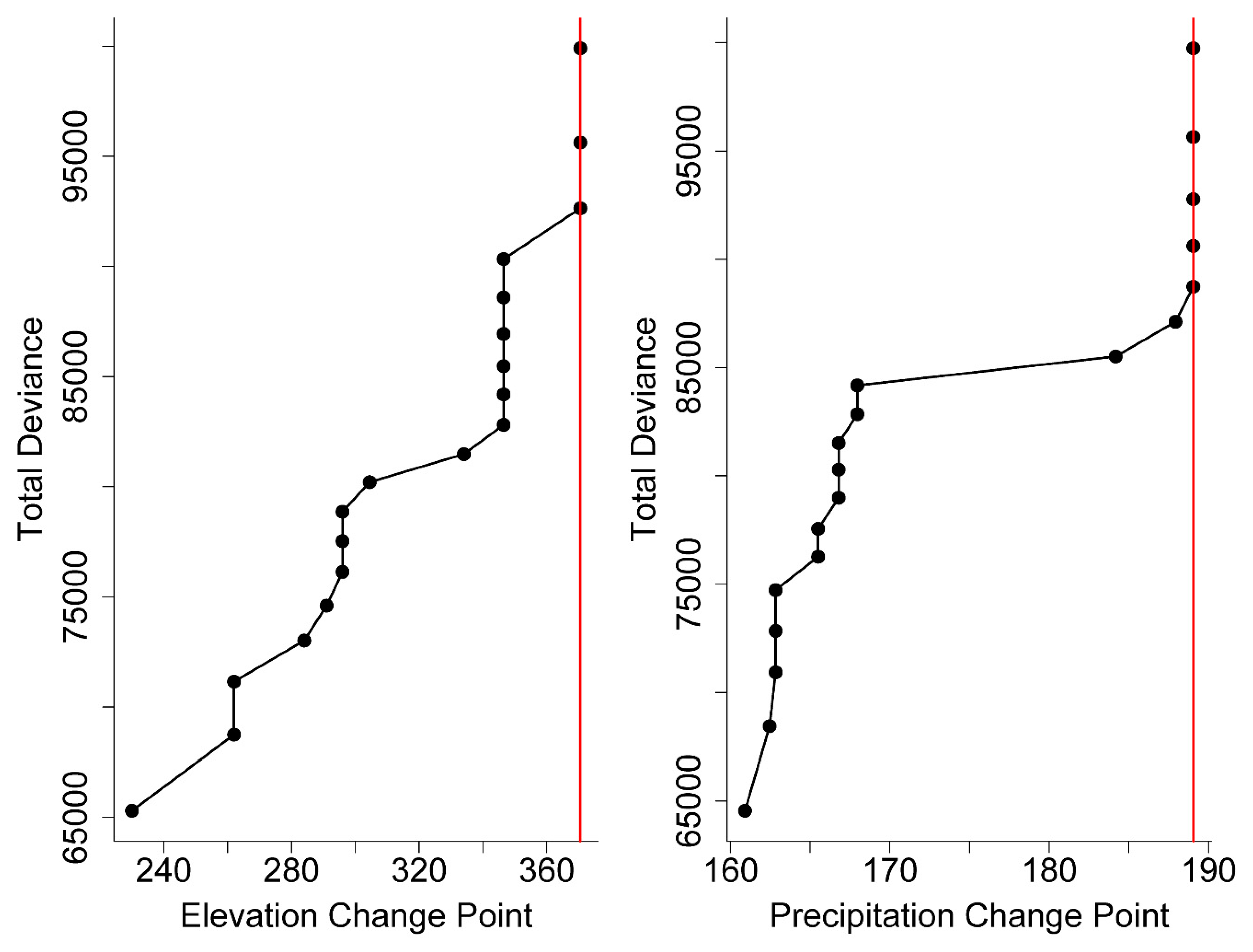
| Segmented Linear Regression Model, Elevation | |||
| Predictors | Estimate | Std. Error | p-Value |
| (Intercept) | 10.321845 | 0.765543 | <0.0001 |
| Elevation | 0.003415 | 0.001111 | 0.0022 |
| Segment | −8.630746 | 1.607162 | <0.0001 |
| Segmented Linear Regression Model, Precipitation | |||
| Predictors | Estimate | Std. Error | p-Value |
| (Intercept) | 81.22493 | 8.71178 | <0.0001 |
| Segment | −74.11321 | 8.99691 | <0.0001 |
| Precipitation | −0.37508 | 0.055 | <0.0001 |
| Precipitation:Segment | 0.36621 | 0.05557 | <0.0001 |
References
- Wright, S.J. Tropical forests in a changing environment. Trends Ecol. Evol. 2005, 20, 553–560. [Google Scholar] [CrossRef] [PubMed]
- Defries, R.; Hansen, A.; Newton, A.C.; Hansen, M.C. Increasing Isolation of Protected Areas in Tropical Forests Over the Past Twenty Years. Ecol. Appl. 2005, 15, 19–26. [Google Scholar] [CrossRef]
- Gardner, T.A.; Barlow, J.; Chazdon, R.; Ewers, R.M.; Harvey, C.A.; Peres, C.A.; Sodhi, N.S. Prospects for tropical forest biodiversity in a human-modified world. Ecol. Lett. 2009, 12, 561–582. [Google Scholar] [CrossRef] [PubMed] [Green Version]
- Laurance, W.F.; Useche, D.C.; Rendeiro, J.; Kalka, M.; Bradshaw, C.J.A.; Sloan, S.P.; Laurance, S.G.; Campbell, M.; Abernethy, K.; Alvarez, P.; et al. Averting biodiversity collapse in tropical forest protected areas. Nature 2012, 489, 290. [Google Scholar] [CrossRef]
- Hansen, M.C.; Potapov, P.V.; Moore, R.; Hancher, M.; Turubanova, S.A.; Tyukavina, A.; Thau, D.; Stehman, S.V.; Goetz, S.J.; Loveland, T.R.; et al. High-resolution global maps of 21st-century forest cover change. Science 2013, 342, 850–853. [Google Scholar] [CrossRef]
- Saatchi, S.S.; Harris, N.L.; Brown, S.; Lefsky, M.; Mitchard, E.T.A.; Salas, W.; Zutta, B.R.; Buermann, W.; Lewis, S.L.; Hagen, S.; et al. Benchmark map of forest carbon stocks in tropical regions across three continents. Proc. Natl. Acad. Sci. USA 2011, 108, 9899–9904. [Google Scholar] [CrossRef] [Green Version]
- Gibbs, H.K.; Brown, S.; Niles, J.O.; Foley, J.A. Monitoring and estimating tropical forest carbon stocks: Making REDD a reality. Environ. Res. Lett. 2007, 2, 045023. [Google Scholar] [CrossRef]
- Fernández-Landa, A.; Algeet-Abarquero, N.; Fernández-Moya, J.; Guillén-Climent, M.; Pedroni, L.; García, F.; Espejo, A.; Villegas, J.; Marchamalo, M.; Bonatti, J.; et al. An Operational Framework for Land Cover Classification in the Context of REDD+ Mechanisms. A Case Study from Costa Rica. Remote Sens. 2016, 8, 593. [Google Scholar] [CrossRef]
- DeFries, R.; Hansen, M.; Townshend, J. Global discrimination of land cover types from metrics derived from AVHRR pathfinder data. Remote Sens. Environ. 1995, 54, 209–222. [Google Scholar] [CrossRef]
- Sexton, J.O.; Song, X.-P.; Feng, M.; Noojipady, P.; Anand, A.; Huang, C.; Kim, D.-H.; Collins, K.M.; Channan, S.; DiMiceli, C. Global, 30-m resolution continuous fields of tree cover: Landsat-based rescaling of MODIS Vegetation Continuous Fields with lidar-based estimates of error. Int. J. Digit. Earth 2013, 6, 427–448. [Google Scholar] [CrossRef]
- Fagan, M.E.; DeFries, R.S. Measurement and Monitoring of the World’s Forests: A Review and Summary of Technical Capability, 2009–2015; Resources for the Future (RFF): Washington, DC, USA, 2009. [Google Scholar]
- Young, N.E.; Anderson, R.S.; Chignell, S.M.; Vorster, A.G.; Lawrence, R.; Evangelista, P.H. A survival guide to Landsat preprocessing. Ecology 2017, 98, 920–932. [Google Scholar] [CrossRef] [PubMed] [Green Version]
- Wilson, A.M.; Jetz, W. Remotely Sensed High-Resolution Global Cloud Dynamics for Predicting Ecosystem and Biodiversity Distributions. PLoS Biol. 2016, 14, e1002415. [Google Scholar] [CrossRef] [PubMed]
- Asner, G.P. Cloud cover in Landsat observations of the Brazilian Amazon. Int. J. Remote Sens. 2001, 22, 3855–3862. [Google Scholar] [CrossRef]
- Bastin, J.-F.; Berrahmouni, N.; Grainger, A.; Maniatis, D.; Mollicone, D.; Moore, R.; Patriarca, C.; Picard, N.; Sparrow, B.; Abraham, E.M.M.; et al. The extent of forest in dryland biomes. Science 2017, 356, 635–638. [Google Scholar] [CrossRef] [PubMed] [Green Version]
- Kalacska, M.; Sanchez-Azofeifa, G.A.; Rivard, B.; Caelli, T.; White, H.P.; Calvo-Alvarado, J.C. Ecological fingerprinting of ecosystem succession: Estimating secondary tropical dry forest structure and diversity using imaging spectroscopy. Remote Sens. Environ. 2007, 108, 82–96. [Google Scholar] [CrossRef]
- Tropek, R.; Beck, J.; Keil, P.; Musilová, Z.; Irena, Š.; Storch, D.; Sedláček, O.; Beck, J.; Keil, P.; Musilová, Z.; et al. Comment on “High-resolution global maps of 21st-century forest cover change”. Science 2014, 344, 981. [Google Scholar] [CrossRef] [PubMed]
- Laurance, W.F.; Sayer, J.; Cassman, K.G. Agricultural expansion and its impacts on tropical nature. Trends Ecol. Evol. 2014, 29, 107–116. [Google Scholar] [CrossRef] [PubMed]
- Fitzherbert, E.B.; Struebig, M.J.; Morel, A.; Danielsen, F.; Brühl, C.A.; Donald, P.F.; Phalan, B. How will oil palm expansion affect biodiversity? Trends Ecol. Evol. 2008, 23, 538–545. [Google Scholar] [CrossRef]
- Hansen, M.C.; Roy, D.P.; Lindquist, E.; Adusei, B.; Justice, C.O.; Altstatt, A. A method for integrating MODIS and Landsat data for systematic monitoring of forest cover and change in the Congo Basin. Remote Sens. Environ. 2008, 112, 2495–2513. [Google Scholar] [CrossRef]
- Harper, G.J.; Steininger, M.K.; Tucker, C.J.; Juhn, D.; Hawkins, F. Fifty years of deforestation and forest fragmentation in Madagascar. Environ. Conserv. 2007, 34, 325–333. [Google Scholar] [CrossRef]
- Zhu, Z.; Woodcock, C.E. Object-based cloud and cloud shadow detection in Landsat imagery. Remote Sens. Environ. 2012, 118, 83–94. [Google Scholar] [CrossRef]
- Hilker, T.; Lyapustin, A.I.; Tucker, C.J.; Hall, F.G.; Myneni, R.B.; Wang, Y.; Bi, J.; Mendes de Moura, Y.; Sellers, P.J. Vegetation dynamics and rainfall sensitivity of the Amazon. Proc. Natl. Acad. Sci. USA 2014, 111, 16041–16046. [Google Scholar] [CrossRef] [PubMed] [Green Version]
- Morton, D.C.; Nagol, J.; Carabajal, C.C.; Rosette, J.; Palace, M.; Cook, B.D.; Vermote, E.F.; Harding, D.J.; North, P.R.J. Amazon forests maintain consistent canopy structure and greenness during the dry season. Nature 2014, 506, 221–224. [Google Scholar] [CrossRef] [PubMed]
- Huete, A.R.; Didan, K.; Shimabukuro, Y.E.; Ratana, P.; Saleska, S.R.; Hutyra, L.R.; Yang, W.; Nemani, R.R.; Myneni, R.B. Amazon rainforests green-up with sunlight in dry season. Geophys. Res. Lett. 2006, 33, 2–5. [Google Scholar] [CrossRef]
- La Barreda-Bautista, B.D.; López-Caloca, A.A.; Couturier, S.; Silván-Cárdenas, J.L. Tropical Dry Forests in the Global Picture: The Challenge of Remote Sensing-Based Change Detection in Tropical Dry Environments; Intechopen: London, UK, 2011. [Google Scholar]
- Arroyo-Mora, J.P.; Sánchez-Azofeifa, G.A.; Kalacska, M.; Rivard, B.; Calvo-Alvarado, J.C.; Janzen, D.H. Secondary forest detection in a neotropical dry forest landscape using landsat 7 ETM + and IKONOS Imagery. Biotropica 2005, 37, 497–507. [Google Scholar] [CrossRef]
- Da Rocha, H.R.; Goulden, M.L.; Miller, S.D.; Menton, M.C.; Pinto, L.D.V.O.; De Freitas, H.C.; E. Silva Figueira, A.M. Seasonality of water and heat fluxes over a tropical forest in eastern Amazonia. Ecol. Appl. 2004, 14, 22–32. [Google Scholar] [CrossRef]
- Feng, X.; Porporato, A.; Rodriguez-Iturbe, I. Changes in rainfall seasonality in the tropics. Nat. Clim. Chang. 2013, 3, 811–815. [Google Scholar] [CrossRef]
- Lopes, A.P.; Nelson, B.W.; Wu, J.; de Alencastro Graça, P.M.L.; Tavares, J.V.; Prohaska, N.; Martins, G.A.; Saleska, S.R. Leaf flush drives dry season green-up of the Central Amazon. Remote Sens. Environ. 2016, 182, 90–98. [Google Scholar] [CrossRef]
- Smith, N.J.; Williams, J.T.; Plucknett, D.L.; Talbot, J.P. Tropical Forests and Their Crops; Cornell University Press: Ithaca, NY, USA, 2018. [Google Scholar]
- Grainger, A. Difficulties in tracking the long-term global trend in tropical forest area. Proc. Natl. Acad. Sci. USA 2008, 105, 818–823. [Google Scholar] [CrossRef] [PubMed] [Green Version]
- Chazdon, R.L. Beyond deforestation: Restoring forests and ecosystem services on degraded lands. Science 2008, 320, 1458–1460. [Google Scholar] [CrossRef]
- Bremer, L.L.; Farley, K.A. Does plantation forestry restore biodiversity or create green deserts? A synthesis of the effects of land-use transitions on plant species richness. Biodivers. Conserv. 2010, 19, 3893–3915. [Google Scholar] [CrossRef] [Green Version]
- Puyravaud, J.P.; Davidar, P.; Laurance, W.F. Cryptic destruction of India’s native forests. Conserv. Lett. 2010, 3, 390–394. [Google Scholar] [CrossRef]
- Phillips, H.R.P.; Newbold, T.; Purvis, A. Land-use effects on local biodiversity in tropical forests vary between continents. Biodivers. Conserv. 2017, 26, 2251–2270. [Google Scholar] [CrossRef] [Green Version]
- Barrett, F.; Mcroberts, R.E.; Tomppo, E.; Cienciala, E.; Waser, L.T. Remote Sensing of Environment A questionnaire-based review of the operational use of remotely sensed data by national forest inventories. Remote Sens. Environ. 2016, 174, 279–289. [Google Scholar] [CrossRef]
- Herold, M. An Assessment of National Forest Monitoring Capabilities in Tropical Non-Annex I Countries: Recommendations for Capacity Building; Center for International Forestry Research: Bogor, Indonesia, 2009. [Google Scholar]
- Sexton, J.O.; Noojipady, P.; Song, X.-P.; Feng, M.; Song, D.-X.; Kim, D.-H.; Anand, A.; Huang, C.; Channan, S.; Pimm, S.L.L.; et al. Conservation policy and the measurement of forests. Nat. Clim. Chang. 2015, 6, 192–196. [Google Scholar] [CrossRef]
- Sannier, C.; McRoberts, R.E.; Fichet, L.-V. Suitability of Global Forest Change data to report forest cover estimates at national level in Gabon. Remote Sens. Environ. 2016, 173, 326–338. [Google Scholar] [CrossRef]
- McRoberts, R.E.; Vibrans, A.C.; Sannier, C.; Næsset, E.; Hansen, M.C.; Walters, B.F.; Lingner, D. V Methods for evaluating the utilities of local and global maps for increasing the precision of estimates of subtropical forest area. Can. J. For. Res. 2016, 924, 924–932. [Google Scholar] [CrossRef]
- Pfaff, A.; Robalino, J.A.; Sanchez-Azofeifa, G.A. Payments for Environmental Services: Empirical Analysis for Costa Rica; Terry Sanford Institute of Public Policy, Duke University: Durham, NC, USA, 2007; pp. 404–424. [Google Scholar]
- Arroyo-Mora, J.P.; Sánchez-Azofeifa, G.A.; Rivard, B.; Calvo, J.C.; Janzen, D.H. Dynamics in landscape structure and composition for the Chorotega region, Costa Rica from 1960 to 2000. Agric. Ecosyst. Environ. 2005, 106, 27–39. [Google Scholar] [CrossRef]
- Holdridge, L.R.; Grenke, W.C. Forest environments in tropical life zones: A pilot study. In Forest Environments in Tropical Life Zones: A Pilot Study; Pergamon Press: Oxford, UK, 1971. [Google Scholar]
- Harris, I.; Jones, P.D.; Osborn, T.J.; Lister, D.H. Updated high-resolution grids of monthly climatic observations—The CRU TS3.10 Dataset. Int. J. Climatol. 2014, 34, 623–642. [Google Scholar] [CrossRef]
- Massey, R.; Sankey, T.T.; Yadav, K.; Congalton, R.; Tilton, J.C.; Thenkabail, P.S. NASA Making Earth System Data Records for Use in Research Environments (MEaSUREs) Global Food Security-Support Analysis Data (GFSAD) Cropland Extent 2010 North America 30 m V001 [Data set]; NASA: Washigton, DC, USA, 2017. [Google Scholar]
- Massey, R.; Sankey, T.T.; Yadav, K.; Congalton, R.G.; Tilton, J.C. Integrating cloud-based workflows in continental-scale cropland extent classification. Remote Sens. Environ. 2018, 219, 162–179. [Google Scholar] [CrossRef]
- Congalton, R.; Green, K. Assessing the Accuracy of Remotely Sensed Data: Principles and Practices; CRC Press: Boca Raton, FL, USA, 2008. [Google Scholar]
- Team, R.C. R: A Language and Environment for Statistical Computing; GBIF: Copenhagen, Denmark, 2014. [Google Scholar]
- Qian, S.S.; King, R.S.; Richardson, C.J. Two statistical methods for the detection of environmental thresholds. Ecol. Modell. 2003, 166, 87–97. [Google Scholar] [CrossRef] [Green Version]
- Strahler, A.H.; Boschetti, L.; Foody, G.M.; Friedl, M.A.; Hansen, M.C.; Herold, M.; Mayaux, P.; Morisette, J.T.; Stehman, S.V.; Woodcock, C.E. GOFC-GOLD-25. Global Land Cover Validation: Recommendations for Evaluation and Accuracy Assessment of Global Land Cover Maps; European Communities: Luxembourg, 2006. [Google Scholar]
- Gilbert-Norton, L.; Wilson, R.; Stevens, J.R.; Beard, K.H. A meta-analytic review of corridor effectiveness. Conserv. Biol. 2010, 24, 660–668. [Google Scholar] [CrossRef] [PubMed]
- Manning, A.D.; Fischer, J.; Lindenmayer, D.B. Scattered trees are keystone structures—Implications for conservation. Biol. Conserv. 2006, 132, 311–321. [Google Scholar] [CrossRef]
- Qiu, S.; He, B.; Zhu, Z.; Liao, Z.; Quan, X. Remote Sensing of Environment Improving Fmask cloud and cloud shadow detection in mountainous area for Landsats 4–8 images. Remote Sens. Environ. 2017, 199, 107–119. [Google Scholar] [CrossRef]
- Li, A.; Jiang, J.; Bian, J.; Deng, W. ISPRS Journal of Photogrammetry and Remote Sensing Combining the matter element model with the associated function of probability transformation for multi-source remote sensing data classification in mountainous regions. ISPRS J. Photogramm. Remote Sens. 2012, 67, 80–92. [Google Scholar] [CrossRef]
- Giao, B.-C.; Kaufman, J.Y. Selection of the 1.375-µm MODIS Channel for Remote Sensing of Cirrus Clouds and Stratospheric Aerosols from Space. J. Atmos. Sci. 1995, 52, 4231–4237. [Google Scholar] [CrossRef]
- Gross, D.; Achard, F.; Dubois, G.; Brink, A.; Prins, H.H.T. Uncertainties in tree cover maps of Sub-Saharan Africa and their implications for measuring progress towards CBD Aichi Targets. Remote Sens. Ecol. Conserv. 2018, 4, 94–112. [Google Scholar] [CrossRef]
- Feng, M.; Sexton, J.O.; Huang, C.; Anand, A.; Channan, S.; Song, X.-P.; Song, D.-X.; Kim, D.-H.; Noojipady, P.; Townshend, J.R. Earth science data records of global forest cover and change: Assessment of accuracy in 1990, 2000, and 2005 epochs. Remote Sens. Environ. 2016, 184, 73–85. [Google Scholar] [CrossRef] [Green Version]
- Hojas-Gascon, L.; Cerutti, P.O.; Eva, H.; Nasi, R.; Martius, C. Monitoring Deforestation and Forest Degradation in the Context of REDD+: Lessons from Tanzania; CIFOR: Bogor, Indonesia, 2015; Volume 124. [Google Scholar]
- Staver, A.C.; Hansen, M.C. Analysis of stable states in global savannas: Is the CART pulling the horse?—A comment. Glob. Ecol. Biogeogr. 2015, 24, 985–987. [Google Scholar] [CrossRef]
- Sorensen, L. A Spatial Analysis Approach to the Global Delineation of Dryland Areas of Relevance to the CBD Programme of Work on Dry and Sub-Humid Lands; UNEP World Conservation Monitoring Centre: Cambridge, UK, 2007. [Google Scholar]
- Staver, A.C.; Archibald, S.; Levin, S.A. The Global Extent and Determinants of Savanna and Forest as Alternative Biome States. Science 2011, 334, 230–233. [Google Scholar] [CrossRef]
- Austin, K.G.; González-Roglich, M.; Schaffer-Smith, D.; Schwantes, A.M.; Swenson, J.J. Trends in size of tropical deforestation events signal increasing dominance of industrial-scale drivers Erratum: Trends in size of tropical deforestation events signal increasing dominance of industrial-scale drivers. Environ. Res. Lett. 2017, 12, 079601. [Google Scholar] [CrossRef]
- Hansen, M.; Potapov, P.; Margono, B.; Stehman, S.; Turubanova, S.; Tyukavina, A. Response to Comment on “High-resolution global maps of 21st-century forest cover change”. Science 2014, 344, 981. [Google Scholar] [CrossRef] [PubMed]
- Gibbs, H.K.; Ruesch, A.S.; Achard, F.; Clayton, M.K.; Holmgren, P.; Ramankutty, N.; Foley, J.A. Tropical forests were the primary sources of new agricultural land in the 1980s and 1990s. Proc. Natl. Acad. Sci. USA 2010, 107, 16732–16737. [Google Scholar] [CrossRef] [PubMed] [Green Version]
- Reiche, J.; Verbesselt, J.; Hoekman, D.; Herold, M. Fusing Landsat and SAR time series to detect deforestation in the tropics. Remote Sens. Environ. 2015, 156, 276–293. [Google Scholar] [CrossRef]
- Dolan, K.; Masek, J.G.; Huang, C.; Sun, G. Regional forest growth rates measured by combining ICESat GLAS and Landsat data. J. Geophys. Res. Biogeosci. 2009, 114. [Google Scholar] [CrossRef]
- Olofsson, P.; Foody, G.M.; Stehman, S.V.; Woodcock, C.E. Remote Sensing of Environment Making better use of accuracy data in land change studies: Estimating accuracy and area and quantifying uncertainty using strati fi ed estimation. Remote Sens. Environ. 2013, 129, 122–131. [Google Scholar] [CrossRef]
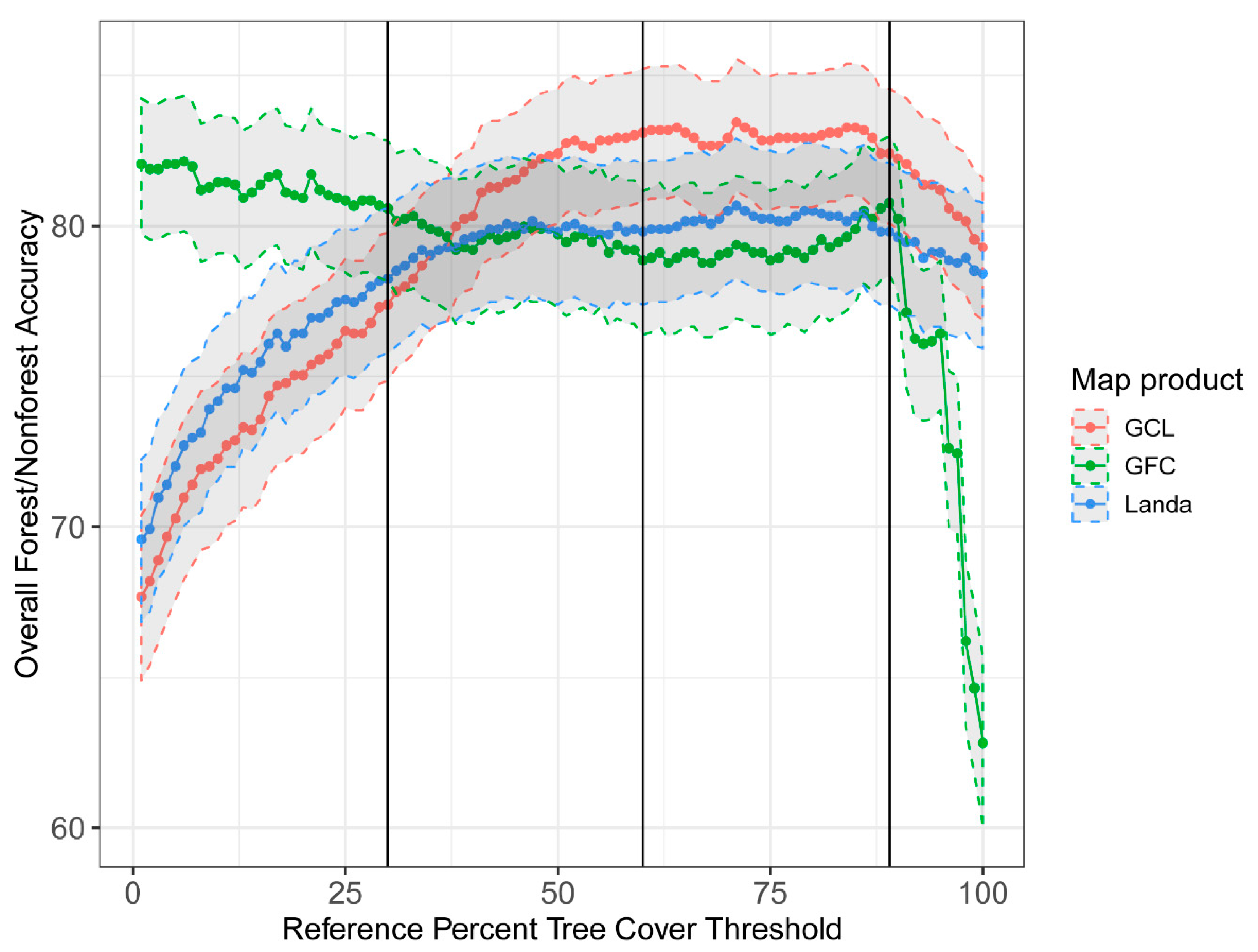
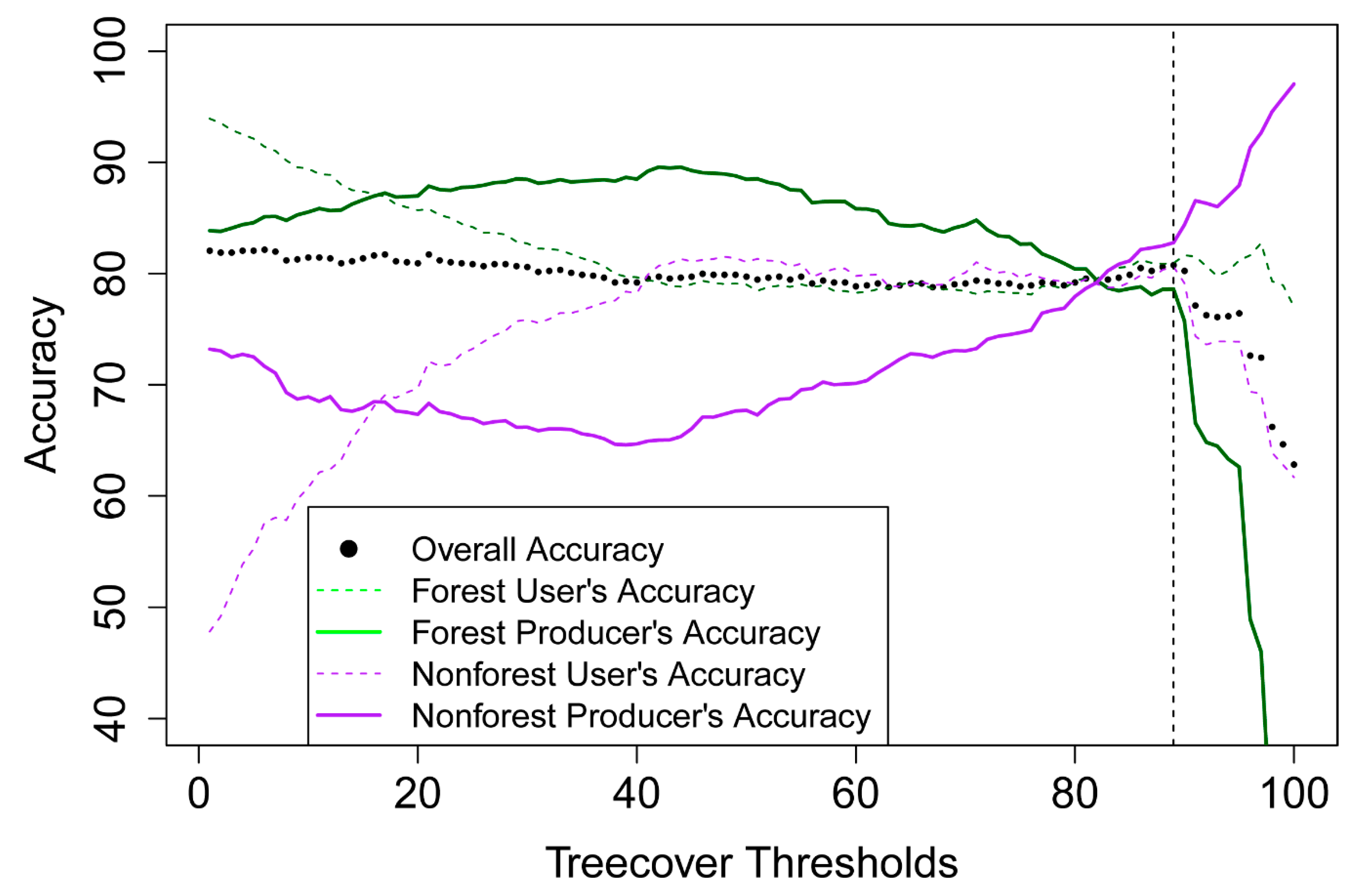
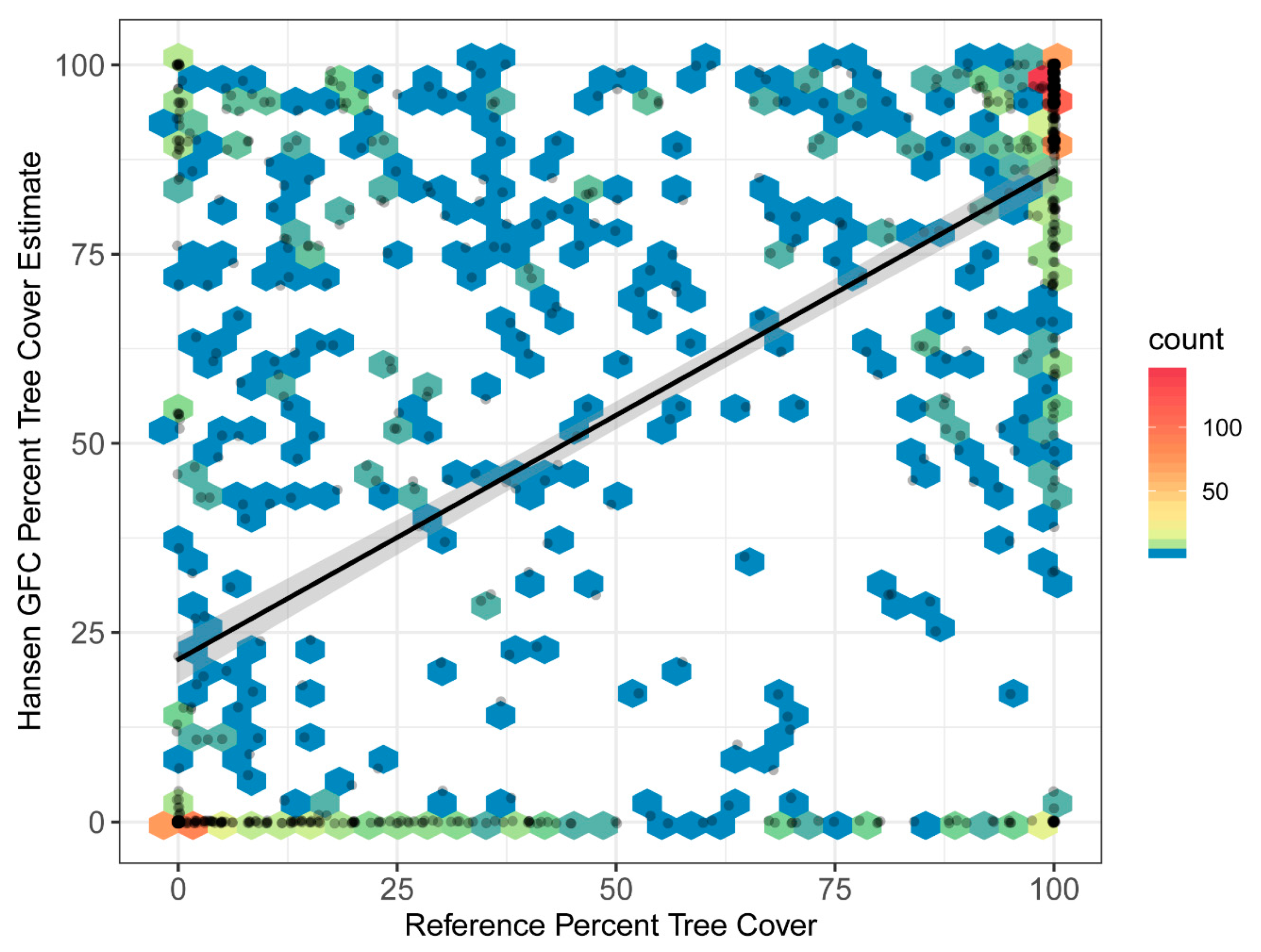
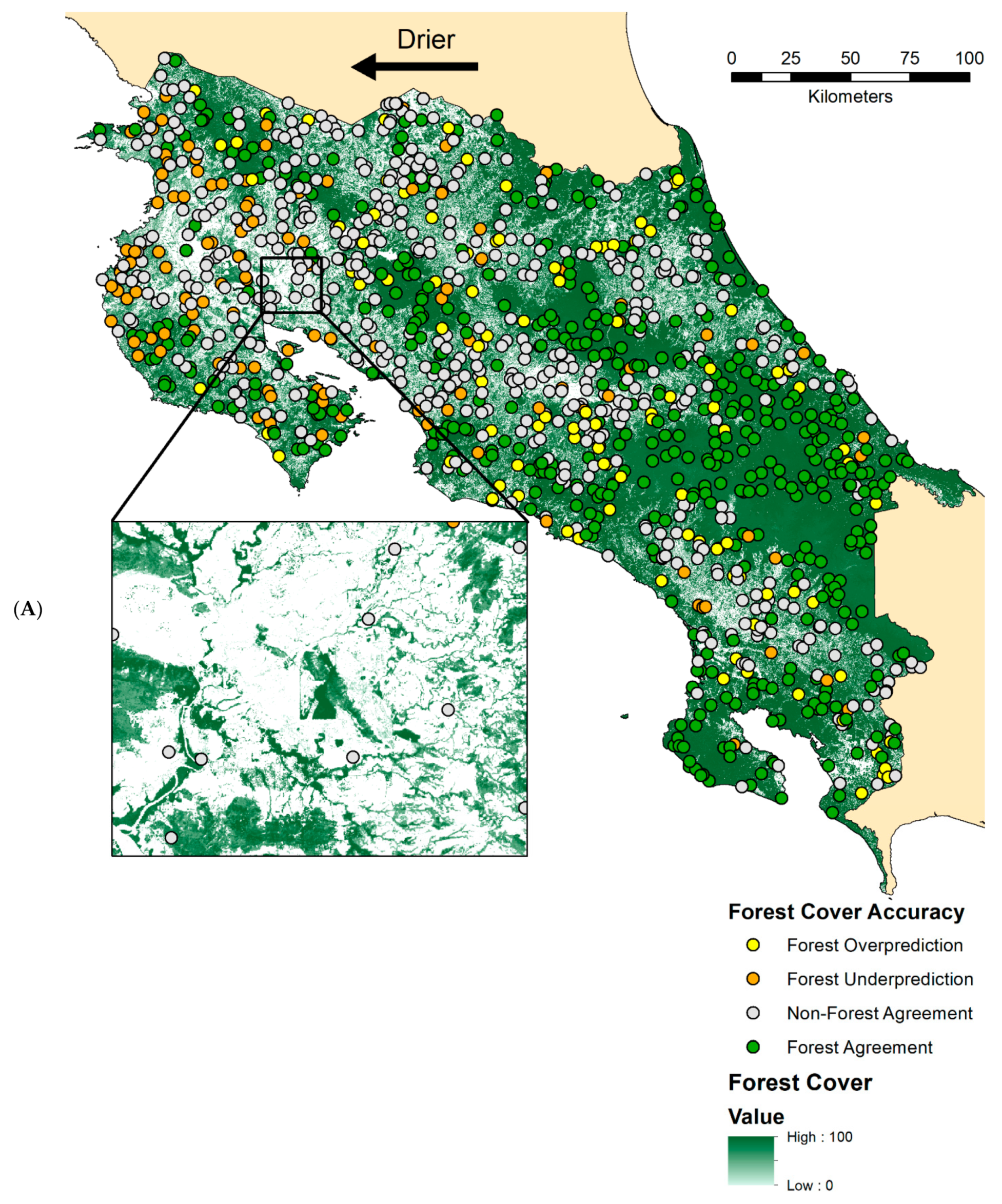
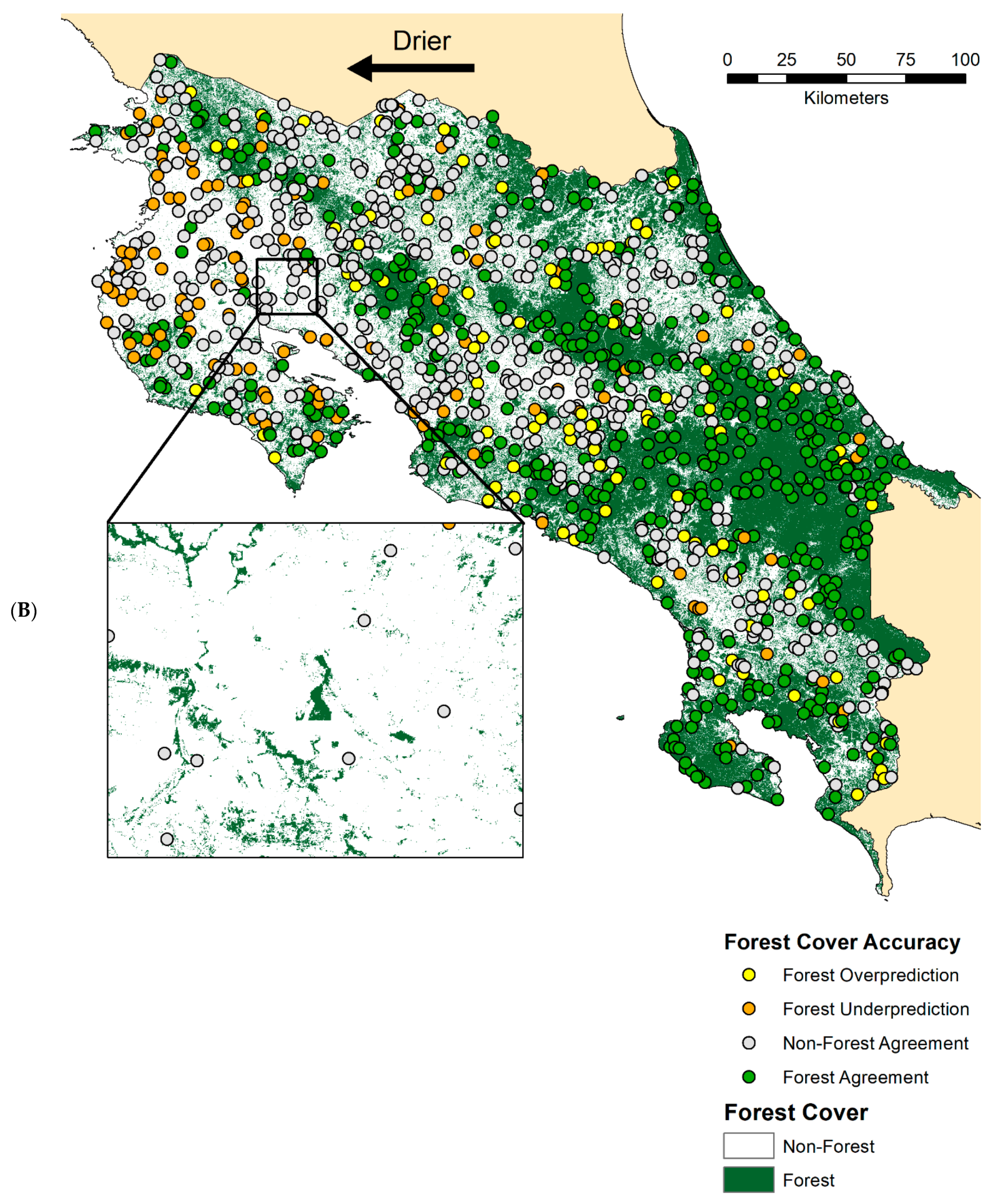
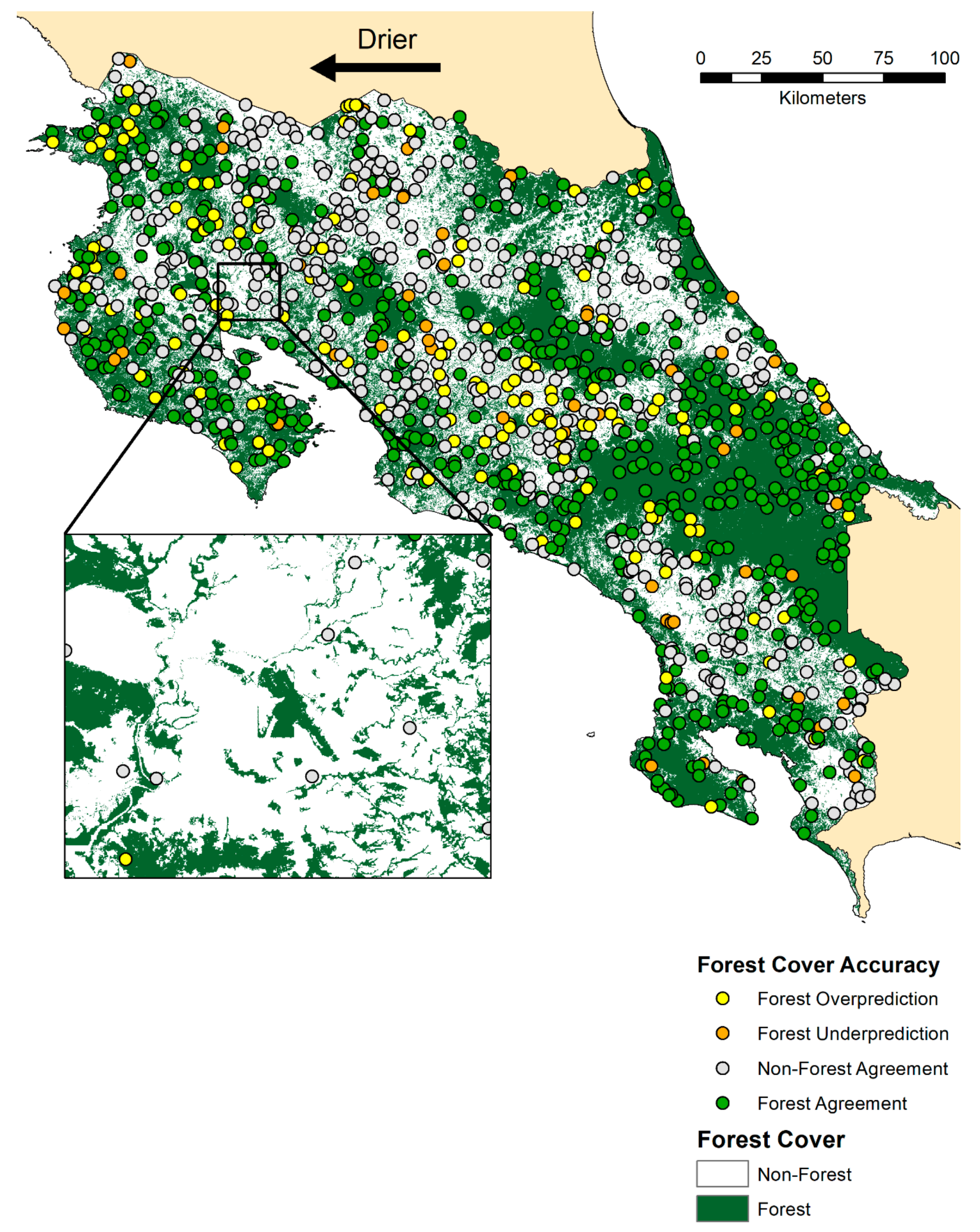
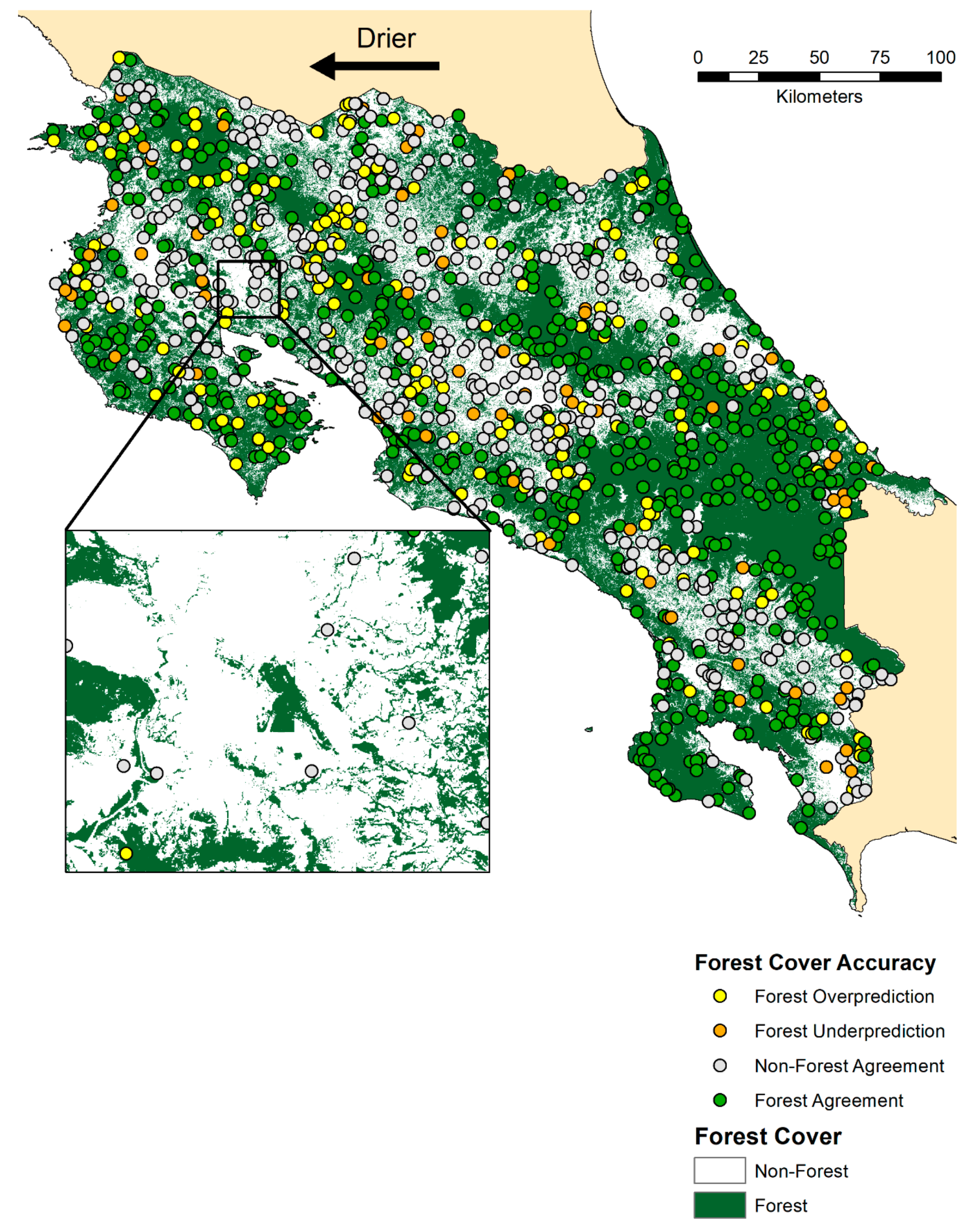
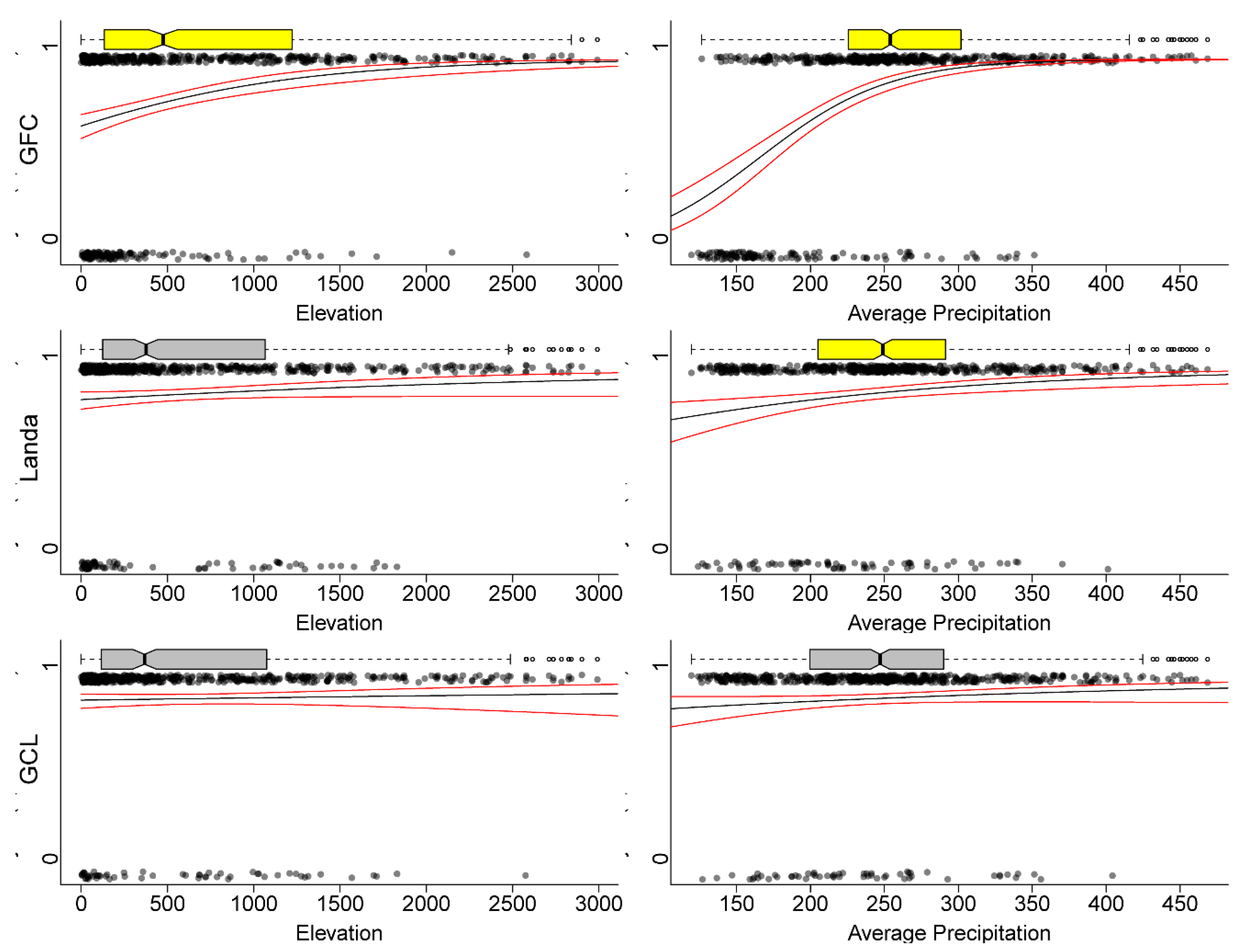
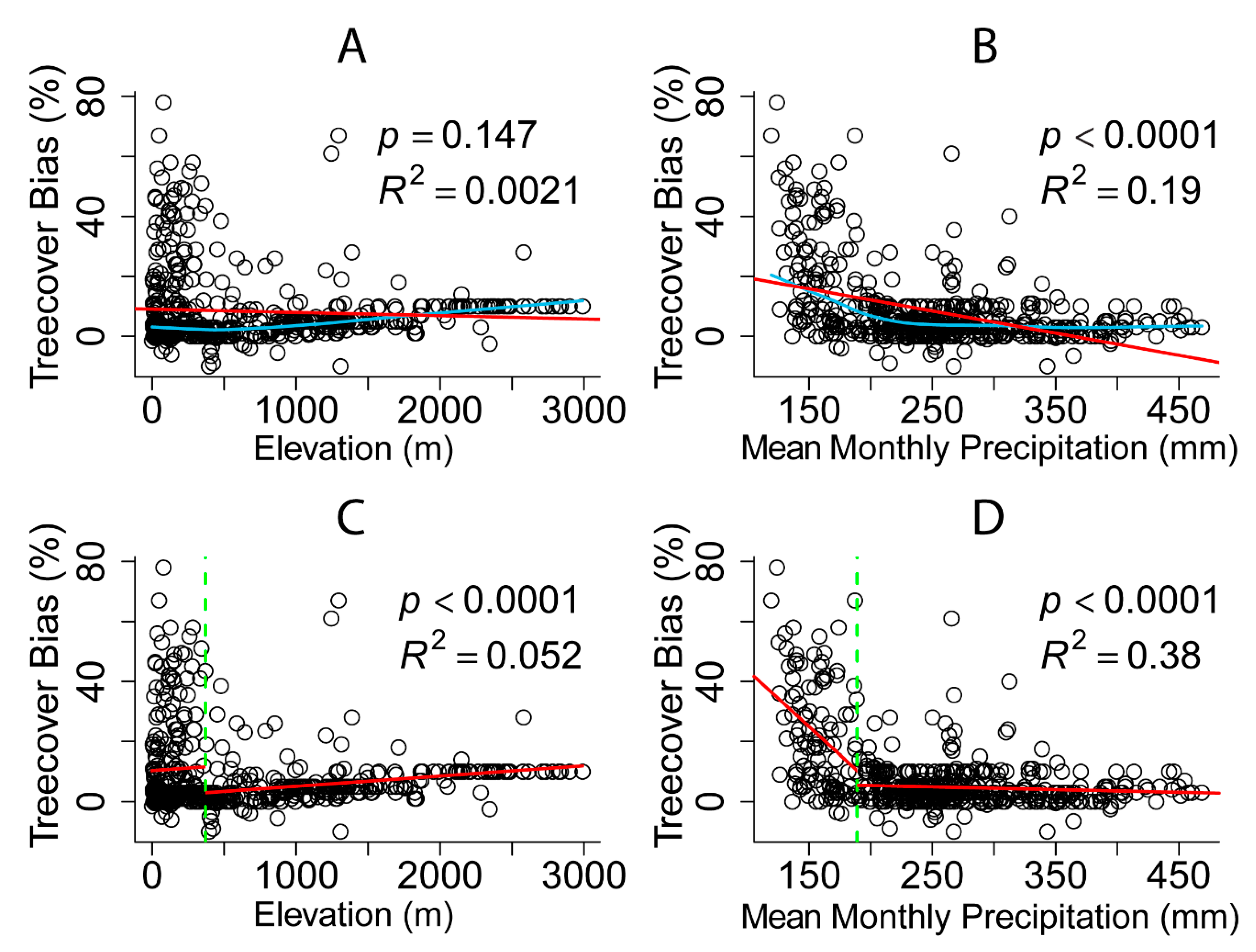
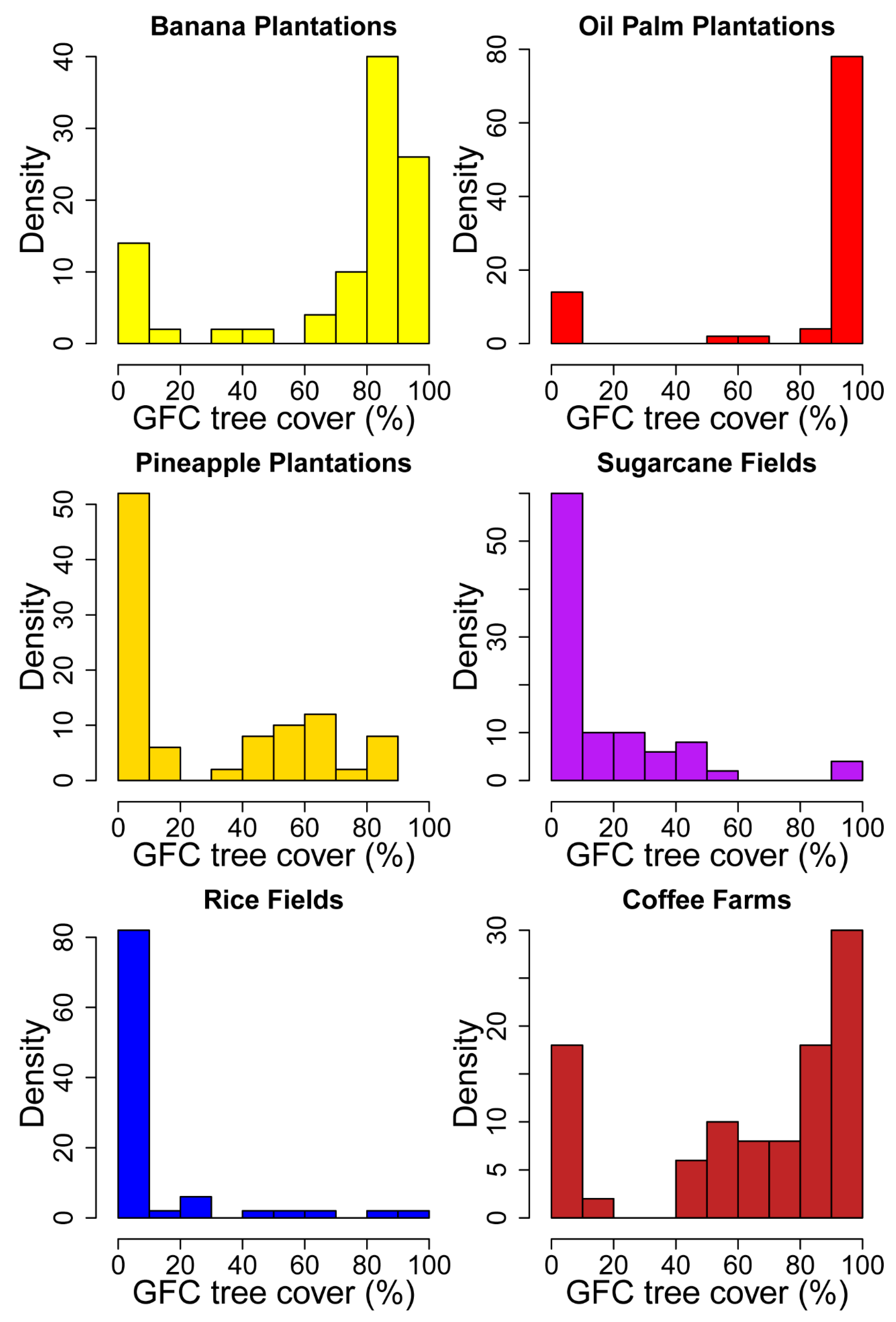
| Global Forest Change (GFC) Tree Cover | Fernandez-Landa et al. 2016 [8] | Global Croplands (GCL) Project | |
|---|---|---|---|
| Purpose | Forest monitoring | REDD+ monitoring | Cropland monitoring |
| Scale | Global | Regional | Global |
| Tree cover data | % Tree cover | Forest/Non-forest | Forest/Non-forest |
| Year Mapped | 2000 (updated to 2015) | 2014 | 2010 |
| Resolution | 30 m | 30 m | 30 m |
| Top Costa Rican Crops by Area Harvested, 2015 | ||
|---|---|---|
| Crop | Area Harvested (ha) | FAOstat Description |
| Coffee, green | 84,133 | Official data |
| Oil palm fruit | 69,426 | Official data |
| Sugarcane | 64,676 | Official data |
| Fruit, fresh * | 51,062 | FAO data based on imputation methodology |
| Rice, paddy | 48,901 | Official data |
| Banana | 43,024 | Official data |
| Pineapple | 40,000 | Official data |
| GFC Map Accuracy | ||||
| Reference | ||||
| Classified | Non-forest | Forest | Total | Users |
| Non-forest | 495 | 119 | 614 | 81% |
| Forest | 103 | 437 | 540 | 81% |
| Total | 598 | 556 | 1154 | |
| Producers | 83% | 79% | ||
| Overall Accuracy | 80.76% | |||
| GCL Map Accuracy | ||||
| Reference | ||||
| Classified | Non-forest | Forest | Total | Users |
| Non-forest | 451 | 56 | 507 | 89% |
| Forest | 147 | 500 | 647 | 77% |
| Total | 598 | 556 | 1154 | |
| Producers | 75% | 90% | ||
| Overall Accuracy | 82.41% | |||
| Landa Map Accuracy | ||||
| Reference | ||||
| Classified | Non-forest | Forest | Total | Users |
| Non-forest | 436 | 71 | 507 | 86% |
| Forest | 162 | 485 | 647 | 75% |
| Total | 598 | 556 | 1154 | |
| Producers | 73% | 87% | ||
| Overall Accuracy | 79.81% | |||
| Crop Type | GFC0 | GFC10 | GFC30 | GFC60 | GFC89 | Landa | GCL |
|---|---|---|---|---|---|---|---|
| Banana | 86 | 86 | 84 | 80 | 52 | 4 | 0 |
| Oil palm | 86 | 86 | 86 | 84 | 80 | 10 | 8 |
| Pineapple | 48 | 48 | 42 | 24 | 2 | 0 | 0 |
| Rice | 24 | 18 | 10 | 8 | 2 | 0 | 2 |
| Sugarcane | 58 | 40 | 22 | 4 | 4 | 4 | 2 |
| Coffee | 82 | 82 | 80 | 66 | 38 | 16 | 4 |
| All crops | 64 | 60 | 54 | 44 | 30 | 6 | 3 |
© 2019 by the authors. Licensee MDPI, Basel, Switzerland. This article is an open access article distributed under the terms and conditions of the Creative Commons Attribution (CC BY) license (http://creativecommons.org/licenses/by/4.0/).
Share and Cite
Cunningham, D.; Cunningham, P.; Fagan, M.E. Identifying Biases in Global Tree Cover Products: A Case Study in Costa Rica. Forests 2019, 10, 853. https://doi.org/10.3390/f10100853
Cunningham D, Cunningham P, Fagan ME. Identifying Biases in Global Tree Cover Products: A Case Study in Costa Rica. Forests. 2019; 10(10):853. https://doi.org/10.3390/f10100853
Chicago/Turabian StyleCunningham, Daniel, Paul Cunningham, and Matthew E. Fagan. 2019. "Identifying Biases in Global Tree Cover Products: A Case Study in Costa Rica" Forests 10, no. 10: 853. https://doi.org/10.3390/f10100853
APA StyleCunningham, D., Cunningham, P., & Fagan, M. E. (2019). Identifying Biases in Global Tree Cover Products: A Case Study in Costa Rica. Forests, 10(10), 853. https://doi.org/10.3390/f10100853



